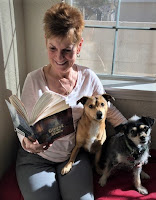By Karen Cioffi, Children's Ghostwriter
Plot twists are an established tool to writing intriguing stories, whether for books, movies, TV, or other. These helpful tools create a more engaging story for the reader.
According to Wikipedia, "A plot twist is a literary technique that introduces a radical change in the direction or expected outcome of the plot in a work of fiction. When it happens near the end of a story, it is known as a twist or surprise ending."
Plot twists stop predictability and can be used in any genre of fiction.
So, what does that mean?
Imagine your reader, midway through the book, saying to herself, “Oh, yeah, she’s the villain. She did it.”
This is predictability.
Sometimes this is a good thing. Some readers like to know what’s going on. They want the obvious.
But, lots of readers like being surprised.
Remember Thelma and Louise?
People were shocked with the ending.
The main characters spent most of the movie desperately running from the police. When faced with the overwhelming and at times unjust criminal system, they chose freedom … in death.
It was different and completely unexpected.
Then there’s the classics of Edgar Allan Poe.
In “The Telltale Heart,” the protagonist kills an old man for an insignificant reason. He cuts up the body and hides the pieces under the floorboards in his house.
After a short while, he begins to hear a heartbeat … the heartbeat of the old man he just murdered, or so he thinks.
With the police there, being called by a neighbor who heard the old man scream while being murdered, the protagonist panics and confesses to the murder.
Poe did have a knack with the macabre.
Then there are the subtle writers like Kate Chopin.
In her short story “The Story of an Hour,” a young woman, Louise, feels oppressed in her marriage, possibly to the point of having heart trouble.
Louise learns that the train her husband was on had crashed and there were no survivors. Locking herself in her room, she began to feel elated … free.
After a while, her sister, thinking she's greifstricken, coaxes Louise out of her room and they walk downstairs. Just then the front door opens and it’s her husband. He didn’t take the train.
Louise drops dead.
Everyone thinks it’s from happiness at seeing her husband alive. The reader knows the truth.
Plot twists can vary and there are a number of them. The three most common, at least in my opinion, are:
1. The Red Herring
With this one, the clues to solving a crime all point to one particular character. The twist is he’s innocent of the crime.
The reader thinks that he’s got it figured out, then BAM.
2. Chekhov’s Gun
Chekhov is quoted as saying, “One must not put a loaded rifle on the stage if no one is thinking of firing it.”
Elaborating on this, S. Shchukin quotes Chekhov as saying, “If you say in the first chapter that there is a rifle hanging on a wall, in the second or third chapter it absolutely must go off. If it’s not going to be fired, it shouldn’t be hanging there.”
While the quote deals with a gun, it can be anything. The point here is to use details deliberately and effectively; they can lead to great plot twists.
3. Shift Suspicion
This plot twist has the reader thinking they may know who committed the crime, but then clues point to another character. Now, the reader isn’t so sure of who the villain is.
What to Look Out For
One thing to keep an eye out for when writing plot twists is to be sure the reader won’t see them coming. Well, at least the majority of readers.
To help do this, quickly think of possible twists your story can take.
If you can quickly think of them, chances are the reader will think of them too. Solution: Don’t use them.
At Writer’s Edit, it advises, “To combat predictability in your plot, try thinking about the complete opposite of every twist or turn you've noted down.” (1)
Along with this, it’s important that your twists are believable. Don’t randomly throw plots twists into your story to try to keep your readers on their toes. The reader won’t like it.
In a Writer’s Digest article by Rachel Scheller, it says, “Readers want their emotional investment to pay off. The twist should never occur in a way that makes them feel tricked, deceived, or insulted. Great twists always deepen, never cheapen, readers’ investment in the story.” (2)
References:
(1) https://writersedit.com/fiction-writing/10-simple-tips-writing-clever-plot-twists/
(2) http://www.writersdigest.com/editor-blogs/there-are-no-rules/4-ways-to-write-a-killer-plot-twist
This article was first published at: https://karencioffiwritingforchildren.com/2018/10/14/writing-plot-twists-into-your-story/
ABOUT THE AUTHOR
Karen Cioffi is an award-winning children’s author and children’s ghostwriter, rewriter, and coach with clients worldwide. She is also the founder and editor-in-chief of Writers on the Move, and an author online platform instructor with WOW! Women on Writing.
Karen’s children’s books include Walking Through Walls and The Case of the Stranded Bear. She also has a DIY book, How to Write Children’s Fiction Books. You can check them out at: https://karencioffiwritingforchildren.com/karens-books/.
If you need help with your children’s story, visit: https://karencioffiwritingforchildren.com.
MORE ABOUT WRITING
The Foundation of Every Children's Story
Writers - Make Your Blog a Powerful Marketing Tool
Why It's Called the The Slush Pile





















